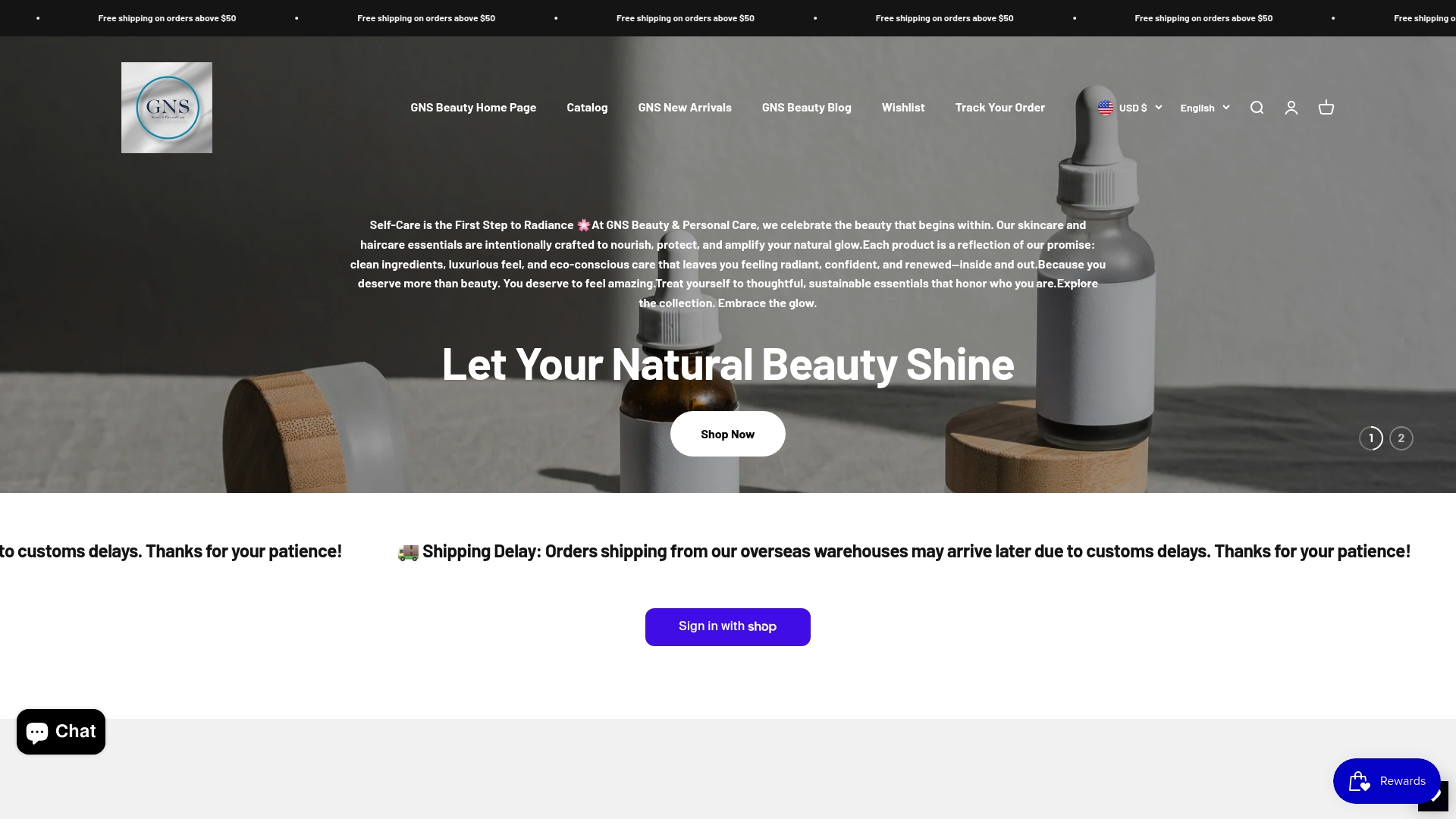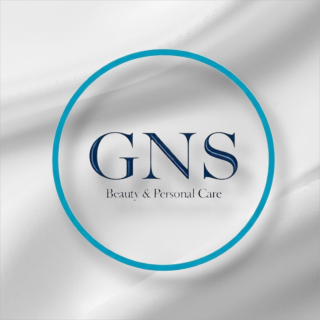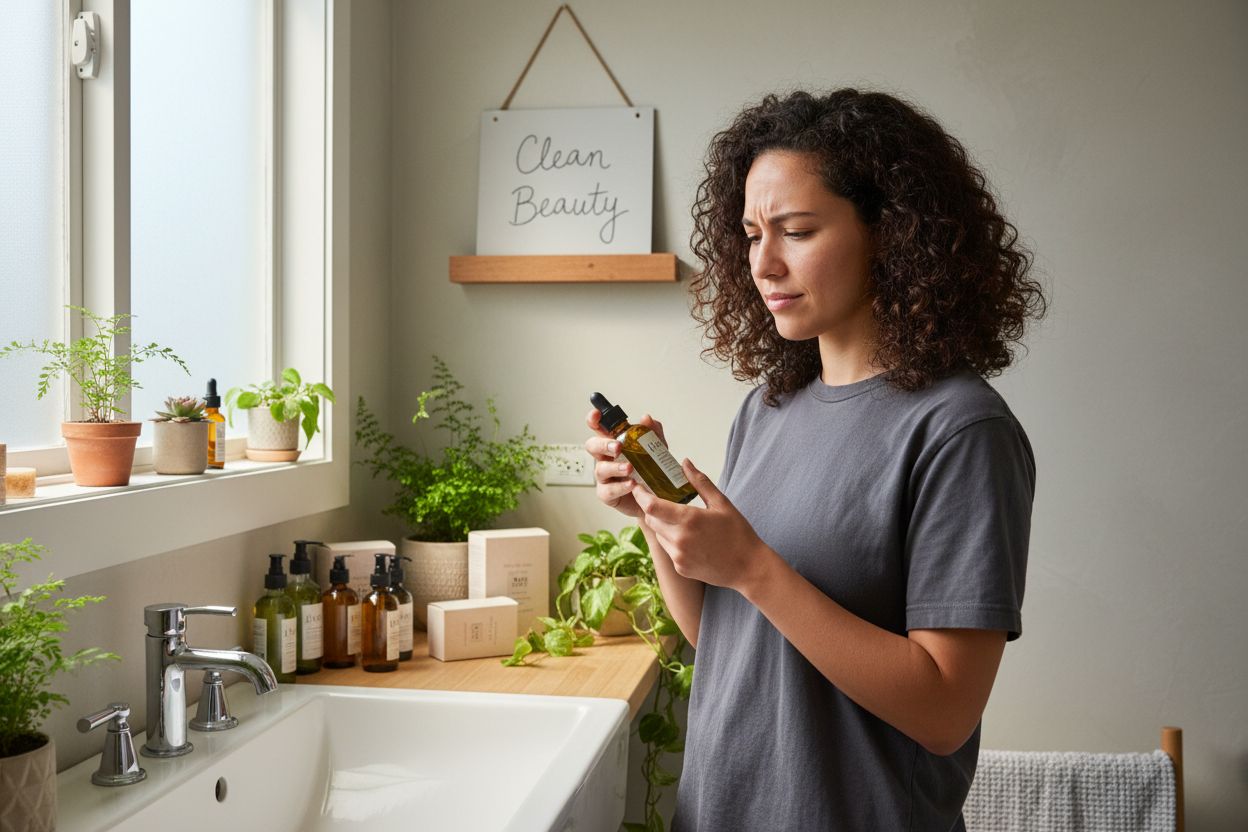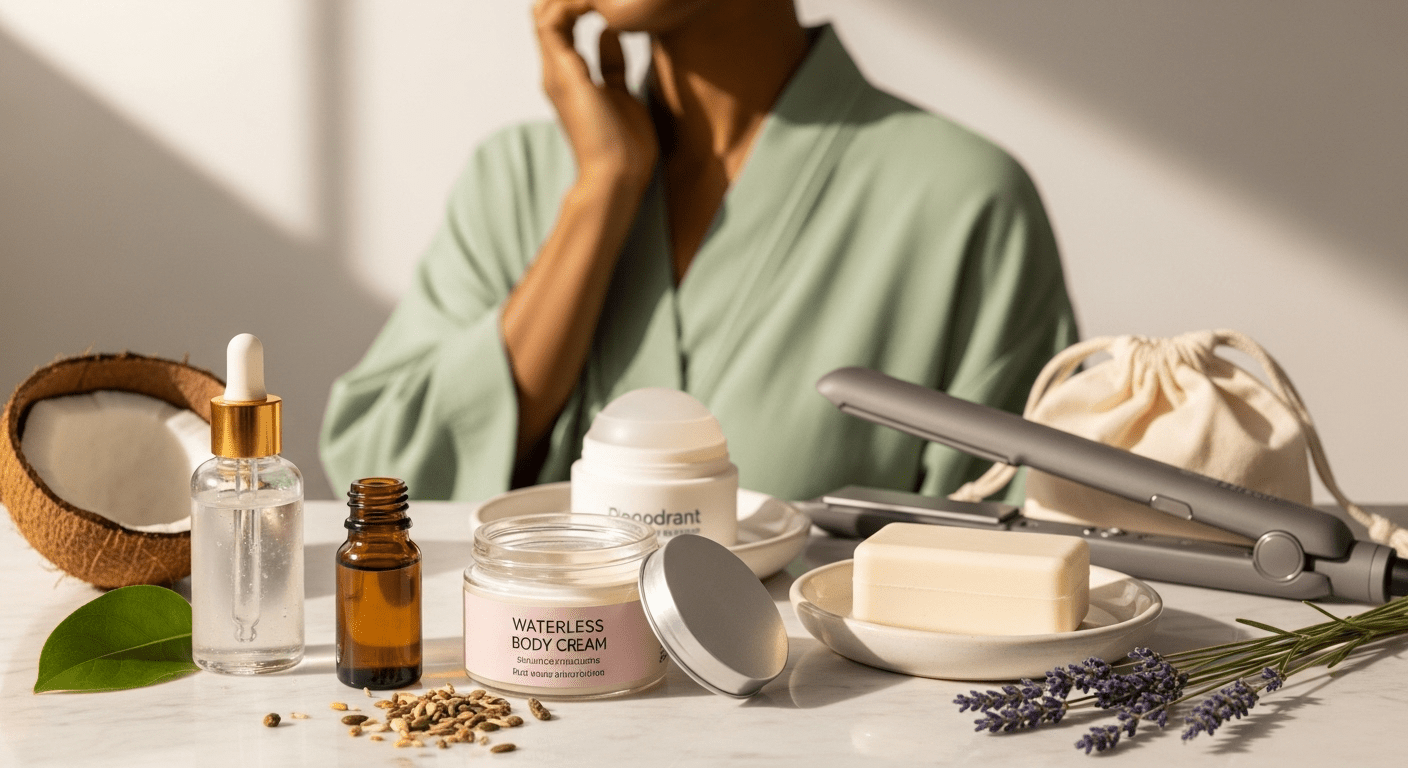Clean beauty is changing the way people think about skincare and makeup. Right now, over 60 percent of consumers check ingredient lists before buying personal care products. Most people expect making the switch is just about going natural or organic. But clean beauty is about much more than looking for plant-based labels. It’s a movement that’s rewriting the rules for personal health, transparency, and even the planet’s future.
Table of Contents
- What Is Clean Beauty And Its Core Principles?
- Why Clean Beauty Matters: Health And Environmental Impact
- Key Ingredients In Clean Beauty Products: What To Look For
- Understanding Labels: How To Identify Clean Beauty Products
- The Future Of Clean Beauty: Trends And Evolving Standards
Quick Summary
| Takeaway | Explanation |
|---|---|
| Prioritize clean beauty for safer products | Clean beauty products avoid harmful chemicals that can impact health, promoting wellness and safety in personal care choices. |
| Understand and avoid toxic ingredients | Recognizing harmful ingredients like parabens and sulfates helps consumers select healthier options and avoid potential health risks. |
| Look for third-party certifications | Certifications like USDA Organic guarantee product safety and environmental responsibility, guiding informed purchasing decisions. |
| Support sustainable packaging practices | Choosing brands that prioritize eco-friendly packaging contributes to reducing the environmental footprint of the beauty industry. |
| Stay informed about changing beauty standards | Keeping updated on evolving clean beauty practices ensures consumers make responsible choices aligned with health and sustainability values. |
What is Clean Beauty and Its Core Principles?
Clean beauty represents a transformative approach to personal care that prioritizes human and environmental wellness through intentional product selection. Unlike traditional beauty standards, this philosophy goes beyond aesthetic outcomes to create holistic solutions that respect both personal health and ecological sustainability.
Defining Clean Beauty
At its core, clean beauty is a comprehensive movement centered on creating and using personal care products that are safe, transparent, and environmentally responsible. This approach carefully examines every ingredient, manufacturing process, and potential ecological impact. Ethical beauty products embody principles that challenge conventional beauty industry practices by prioritizing:
- Ingredient purity and non-toxicity
- Minimal environmental footprint
- Cruelty-free production methods
- Transparent supply chains
- Sustainable packaging solutions
The Fundamental Principles
Clean beauty operates on several key principles that distinguish it from mainstream beauty approaches.
![]() These principles are rooted in scientific understanding and ethical considerations. According to research from the Environmental Working Group, consumers are increasingly demanding products that meet rigorous safety and sustainability standards.
These principles are rooted in scientific understanding and ethical considerations. According to research from the Environmental Working Group, consumers are increasingly demanding products that meet rigorous safety and sustainability standards.
The movement emphasizes avoiding harmful chemicals such as parabens, phthalates, sulfates, and synthetic fragrances. Instead, clean beauty brands focus on natural, organic, and scientifically validated ingredients that offer genuine benefits without compromising long-term health.
Moreover, clean beauty transcends individual product selection. It represents a broader commitment to personal wellness, environmental stewardship, and responsible consumption. By choosing clean beauty products, consumers actively participate in a global movement that champions health, transparency, and ecological balance.
Why Clean Beauty Matters: Health and Environmental Impact
Clean beauty extends far beyond aesthetic preferences, representing a critical intersection between personal wellness and global environmental sustainability. Understanding its broader implications reveals why this movement has transformed from a niche trend to a powerful consumer-driven revolution.
Personal Health Considerations
Traditional beauty and personal care products often contain potentially harmful chemicals that can penetrate human skin and enter biological systems. Research from the National Institutes of Health demonstrates that many synthetic ingredients may pose significant long-term health risks. These risks include:
- Hormone disruption
- Potential carcinogenic effects
- Increased skin sensitivity
- Allergic reactions
- Cellular damage from prolonged exposure
By prioritizing clean beauty products, consumers actively reduce their exposure to toxic substances while supporting their body’s natural protective mechanisms. The commitment goes beyond surface-level skincare, representing a proactive approach to holistic health management.
Environmental Sustainability Impact
The environmental footprint of conventional beauty industry practices is substantial. Eco-friendly personal care tools represent a critical strategy in addressing these challenges. Clean beauty brands typically focus on sustainable sourcing, responsible manufacturing, and minimizing waste through:
- Biodegradable packaging materials
- Reduced carbon emissions during production
- Ethical ingredient procurement
- Water conservation practices
- Supporting regenerative agricultural methods
Moreover, clean beauty champions a circular economy model that reimagines product lifecycles. By selecting brands committed to environmental stewardship, consumers directly contribute to global sustainability efforts, transforming personal care choices into meaningful ecological actions.
Key Ingredients in Clean Beauty Products: What to Look For
Clean beauty is fundamentally about understanding and selecting ingredients that nourish, protect, and support both personal wellness and environmental sustainability.
 Navigating this landscape requires an informed approach to ingredient selection and comprehension.
Navigating this landscape requires an informed approach to ingredient selection and comprehension.
Natural and Plant-Based Powerhouses
Research from the National Institutes of Health highlights the remarkable potential of plant-derived ingredients in skincare and personal care products. Clean beauty prioritizes ingredients that are:
- Minimally processed
- Sourced sustainably
- Rich in natural antioxidants
- Free from synthetic additives
- Biodegradable and environmentally friendly
Key natural ingredients that exemplify clean beauty principles include botanical oils like jojoba, argan, and rosehip, which offer profound skin-nourishing properties without introducing harmful synthetic chemicals. These ingredients provide essential nutrients, support skin barrier function, and deliver targeted benefits such as hydration, healing, and protection.
Ingredients to Avoid
Equally critical in clean beauty is understanding which ingredients to eliminate from your personal care routine. Beauty essentials often contain potentially harmful substances that consumers should proactively avoid:
- Parabens
- Phthalates
- Formaldehyde
- Synthetic fragrances
- Triclosan
- Petroleum derivatives
- Silicones
These ingredients have been linked to potential health risks including hormone disruption, skin irritation, and long-term cellular damage. Clean beauty advocates prioritize transparency, encouraging consumers to scrutinize ingredient lists and understand the potential impact of each component on personal health and environmental wellness.
The table below summarizes some of the most common harmful ingredients in traditional beauty products and the potential health risks associated with each.
| Ingredient | Potential Health Risks |
|---|---|
| Parabens | Hormone disruption, potential carcinogen |
| Phthalates | Hormone disruption, allergic reactions |
| Formaldehyde | Carcinogenic, skin irritation |
| Synthetic Fragrances | Allergic reactions, skin sensitivity |
| Triclosan | Hormone disruption, potential carcinogen |
| Petroleum Derivatives | Skin irritation, long-term cellular damage |
| Silicones | Skin buildup, potential irritation |
Understanding Labels: How to Identify Clean Beauty Products
Deciphering clean beauty product labels requires a strategic approach that goes beyond surface-level marketing claims.
Consumers must develop critical skills to navigate complex product information and make informed purchasing decisions that align with their wellness and environmental values.
Certification and Authenticity Markers
Third-party certifications serve as critical indicators of a product’s clean beauty credentials. Research from environmental standards organizations reveals that legitimate certifications provide consumers with reliable evidence of product safety and sustainability. Key certification labels consumers should recognize include:
- USDA Organic
- EWG Verified
- Leaping Bunny (Cruelty-Free)
- COSMOS Organic
- B Corp Certification
These certifications demonstrate a brand’s commitment to rigorous ingredient screening, ethical manufacturing processes, and transparent supply chain management. Each label represents a specific set of standards that go beyond conventional beauty industry regulations.
This table provides an overview of leading clean beauty certifications mentioned in the article and the main focus area each certification represents.
| Certification | Primary Focus |
|---|---|
| USDA Organic | Organic ingredient compliance |
| EWG Verified | Health and ingredient safety standards |
| Leaping Bunny | Cruelty-free (no animal testing) |
| COSMOS Organic | Sustainable, organic, and eco-friendly criteria |
| B Corp Certification | Social and environmental performance, transparency |
Decoding Ingredient Lists
How to choose cruelty-free makeup starts with understanding ingredient nomenclature. Clean beauty product labels typically follow specific labeling conventions that help informed consumers make educated choices. Key red flags in ingredient lists include chemical names ending in ‘-paraben’, ‘-sulfate’, and synthetic fragrances labeled generically as ‘parfum’.
Ingredients are usually listed in descending order of concentration, allowing consumers to quickly identify the primary components. Natural and organic products will prominently feature botanical extracts, essential oils, and plant-based ingredients at the top of their lists, signaling a commitment to clean beauty principles.
The Future of Clean Beauty: Trends and Evolving Standards
Clean beauty is rapidly transforming from a niche market segment into a comprehensive global movement that integrates technological innovation, environmental consciousness, and holistic wellness principles. This evolution represents a fundamental reimagining of personal care industry standards and consumer expectations.
Technological Innovation in Clean Beauty
Research from biotechnology journals reveals groundbreaking developments that are reshaping clean beauty’s technological landscape. Emerging trends demonstrate how scientific advancements are creating more sustainable, ethical, and effective personal care solutions:
- Lab-grown botanical ingredients
- Advanced green chemistry techniques
- Precision fermentation for ingredient production
- Molecular mapping of natural compounds
- Microbiome-friendly formulations
These innovations enable brands to develop products that are not only safer and more effective but also substantially reduce environmental impact. Biotechnology is becoming a critical driver in creating high-performance clean beauty solutions that meet increasingly sophisticated consumer demands.
Regulatory and Consumer Expectations
Latest beauty trends for 2025 indicate a significant shift towards more transparent, accountable beauty standards. Consumers are demanding comprehensive information about product origins, environmental impact, and ethical manufacturing processes. Key future developments include:
- Stricter ingredient disclosure requirements
- Enhanced third-party certification processes
- Greater emphasis on supply chain transparency
- Increased investment in recyclable packaging
- Comprehensive carbon footprint reporting
The clean beauty movement is progressively establishing itself as a powerful catalyst for systemic change in the personal care industry, prioritizing human and planetary health through innovative, responsible practices.
Make Clean Beauty Simple With GNS Beauty
Are you struggling to identify truly clean beauty products and separate real transparency from confusing labels? Many people share the pain of wanting safer choices but feel overwhelmed by ingredient lists and growing concerns about synthetic chemicals. As explored in our beginner’s guide, clean beauty means prioritizing your health and the planet without feeling lost in industry jargon or misleading claims.

Take control of your wellness and elevate your self-care routine by exploring the premium, eco-conscious collection at GNS Beauty & Personal Care. Browse high-quality, ethically sourced beauty essentials designed for real results and real peace of mind. Now is the perfect moment to begin your journey toward healthier, more confident beauty by choosing products that match your values. Start making empowered choices today and experience the clean beauty difference at GNS Beauty & Personal Care.
Frequently Asked Questions
What is clean beauty?
Clean beauty is a movement focused on creating personal care products that are safe, transparent, and environmentally responsible. It prioritizes ingredient purity, non-toxicity, cruelty-free production methods, and sustainable packaging solutions.
Why is clean beauty important for my health?
Clean beauty helps reduce exposure to harmful chemicals commonly found in traditional beauty products, which can lead to long-term health risks. By choosing clean beauty products, consumers support their overall wellness and protect their skin from potential irritants.
What should I look for in clean beauty products?
When selecting clean beauty products, look for natural and plant-based ingredients that are minimally processed and sustainably sourced. Avoid harmful chemicals like parabens, phthalates, and synthetic fragrances that can pose health risks.
How can I identify clean beauty certifications?
Look for third-party certifications on product labels, such as USDA Organic, EWG Verified, and Leaping Bunny (Cruelty-Free). These certifications signify that the products meet rigorous safety and sustainability standards.








Leave a comment
All comments are moderated before being published.
This site is protected by hCaptcha and the hCaptcha Privacy Policy and Terms of Service apply.